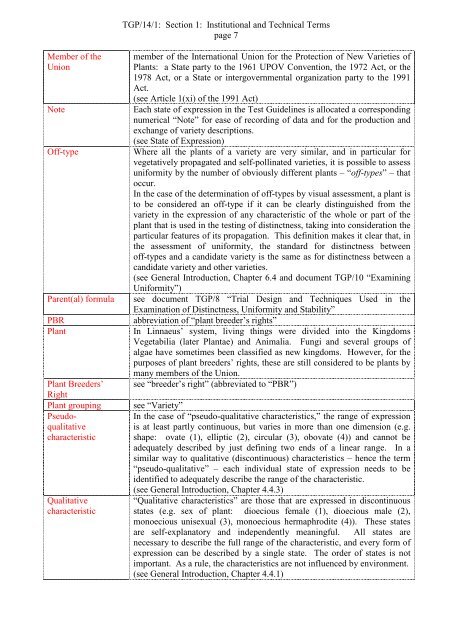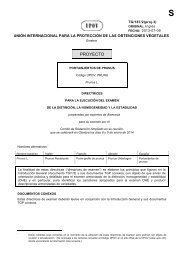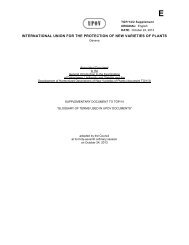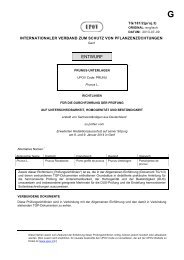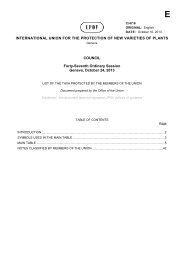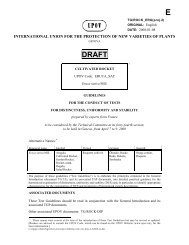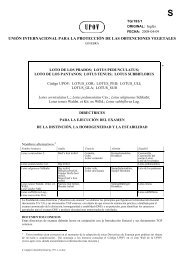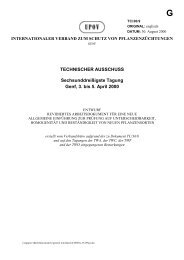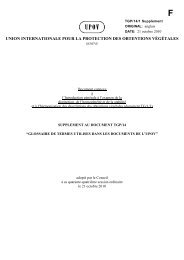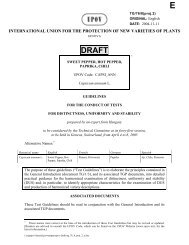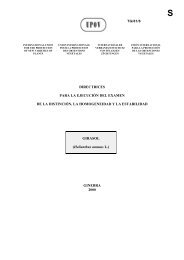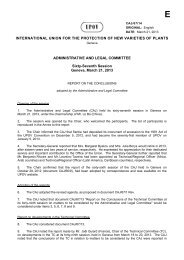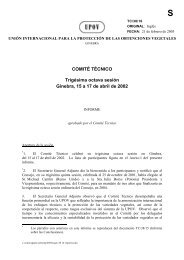E - International Union for the Protection of New Varieties of Plants
E - International Union for the Protection of New Varieties of Plants
E - International Union for the Protection of New Varieties of Plants
You also want an ePaper? Increase the reach of your titles
YUMPU automatically turns print PDFs into web optimized ePapers that Google loves.
TGP/14/1: Section 1: Institutional and Technical Terms<br />
page 7<br />
Member <strong>of</strong> <strong>the</strong> member <strong>of</strong> <strong>the</strong> <strong>International</strong> <strong>Union</strong> <strong>for</strong> <strong>the</strong> <strong>Protection</strong> <strong>of</strong> <strong>New</strong> <strong>Varieties</strong> <strong>of</strong><br />
<strong>Union</strong><br />
<strong>Plants</strong>: a State party to <strong>the</strong> 1961 UPOV Convention, <strong>the</strong> 1972 Act, or <strong>the</strong><br />
1978 Act, or a State or intergovernmental organization party to <strong>the</strong> 1991<br />
Act.<br />
(see Article 1(xi) <strong>of</strong> <strong>the</strong> 1991 Act)<br />
Note<br />
Each state <strong>of</strong> expression in <strong>the</strong> Test Guidelines is allocated a corresponding<br />
numerical “Note” <strong>for</strong> ease <strong>of</strong> recording <strong>of</strong> data and <strong>for</strong> <strong>the</strong> production and<br />
exchange <strong>of</strong> variety descriptions.<br />
(see State <strong>of</strong> Expression)<br />
Off-type<br />
Where all <strong>the</strong> plants <strong>of</strong> a variety are very similar, and in particular <strong>for</strong><br />
vegetatively propagated and self-pollinated varieties, it is possible to assess<br />
uni<strong>for</strong>mity by <strong>the</strong> number <strong>of</strong> obviously different plants – “<strong>of</strong>f-types” – that<br />
occur.<br />
In <strong>the</strong> case <strong>of</strong> <strong>the</strong> determination <strong>of</strong> <strong>of</strong>f-types by visual assessment, a plant is<br />
to be considered an <strong>of</strong>f-type if it can be clearly distinguished from <strong>the</strong><br />
variety in <strong>the</strong> expression <strong>of</strong> any characteristic <strong>of</strong> <strong>the</strong> whole or part <strong>of</strong> <strong>the</strong><br />
plant that is used in <strong>the</strong> testing <strong>of</strong> distinctness, taking into consideration <strong>the</strong><br />
particular features <strong>of</strong> its propagation. This definition makes it clear that, in<br />
<strong>the</strong> assessment <strong>of</strong> uni<strong>for</strong>mity, <strong>the</strong> standard <strong>for</strong> distinctness between<br />
<strong>of</strong>f-types and a candidate variety is <strong>the</strong> same as <strong>for</strong> distinctness between a<br />
candidate variety and o<strong>the</strong>r varieties.<br />
(see General Introduction, Chapter 6.4 and document TGP/10 “Examining<br />
Uni<strong>for</strong>mity”)<br />
Parent(al) <strong>for</strong>mula see document TGP/8 “Trial Design and Techniques Used in <strong>the</strong><br />
Examination <strong>of</strong> Distinctness, Uni<strong>for</strong>mity and Stability”<br />
PBR<br />
abbreviation <strong>of</strong> “plant breeder’s rights”<br />
Plant<br />
In Linnaeus’ system, living things were divided into <strong>the</strong> Kingdoms<br />
Vegetabilia (later Plantae) and Animalia. Fungi and several groups <strong>of</strong><br />
algae have sometimes been classified as new kingdoms. However, <strong>for</strong> <strong>the</strong><br />
purposes <strong>of</strong> plant breeders’ rights, <strong>the</strong>se are still considered to be plants by<br />
many members <strong>of</strong> <strong>the</strong> <strong>Union</strong>.<br />
Plant Breeders’ see “breeder’s right” (abbreviated to “PBR”)<br />
Right<br />
Plant grouping<br />
Pseudoqualitative<br />
characteristic<br />
Qualitative<br />
characteristic<br />
see “Variety”<br />
In <strong>the</strong> case <strong>of</strong> “pseudo-qualitative characteristics,” <strong>the</strong> range <strong>of</strong> expression<br />
is at least partly continuous, but varies in more than one dimension (e.g.<br />
shape: ovate (1), elliptic (2), circular (3), obovate (4)) and cannot be<br />
adequately described by just defining two ends <strong>of</strong> a linear range. In a<br />
similar way to qualitative (discontinuous) characteristics – hence <strong>the</strong> term<br />
“pseudo-qualitative” – each individual state <strong>of</strong> expression needs to be<br />
identified to adequately describe <strong>the</strong> range <strong>of</strong> <strong>the</strong> characteristic.<br />
(see General Introduction, Chapter 4.4.3)<br />
“Qualitative characteristics” are those that are expressed in discontinuous<br />
states (e.g. sex <strong>of</strong> plant: dioecious female (1), dioecious male (2),<br />
monoecious unisexual (3), monoecious hermaphrodite (4)). These states<br />
are self-explanatory and independently meaningful. All states are<br />
necessary to describe <strong>the</strong> full range <strong>of</strong> <strong>the</strong> characteristic, and every <strong>for</strong>m <strong>of</strong><br />
expression can be described by a single state. The order <strong>of</strong> states is not<br />
important. As a rule, <strong>the</strong> characteristics are not influenced by environment.<br />
(see General Introduction, Chapter 4.4.1)


